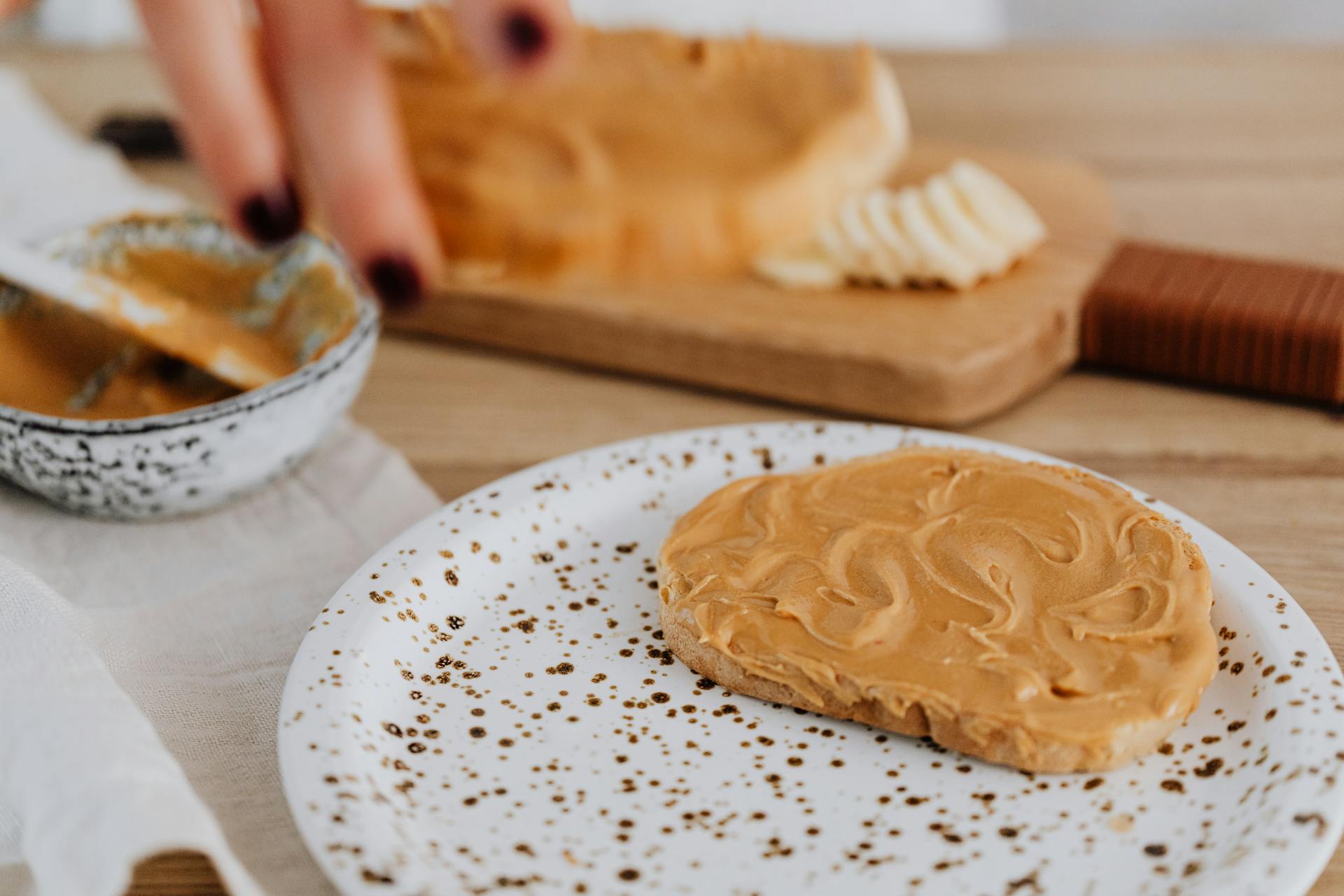
Making homemade dog treats for allergic dogs is a great way to ensure your furry friend gets the nutrients they need without exposing them to harsh chemicals or common allergens.
Sweet potatoes are a great base for homemade dog treats as they're easily digestible and rich in fiber, vitamins, and minerals.
Many commercial dog treats contain fillers like corn and wheat, which can exacerbate allergies.
Using natural ingredients like peanut butter and pumpkin can help soothe itchy skin and reduce inflammation in allergic dogs.
Intriguing read: Can Dogs Be Allergic to Salmon Dog Food
Understanding Food Allergies
Food allergies in dogs are a common issue, and it's essential to understand what causes them. According to the Clinical Nutrition Team at the Cummings School of Veterinary Medicine at Tufts University, food allergies happen when a dog's immune system misidentifies a protein within food as an invader.
Food allergies can be frustrating for dogs and their owners, as there isn't a single test to figure things out. A food allergy involves an immune system response where the body produces antibodies to a component of the food, typically affecting multiple organ systems.
Some common ingredients that trigger food allergies include beef, chicken, eggs, dairy, lamb, and soy. These ingredients are often found in commercially available dog foods and treats.
A food intolerance, on the other hand, does not involve an immune system response and is generally localized to the digestive tract. Food intolerances can be caused by consuming certain ingredients like food additives, spices, and bacteria, fungi, parasites, or viruses.
If you suspect your dog has a food allergy or sensitivity, look for patterns in symptoms that arise after your pet eats certain carbohydrates or proteins. These symptoms may include digestive tract upset, reduced appetite, vomiting, stool abnormalities, skin inflammation, and ear inflammation.
Here are some common signs of a food allergy or intolerance:
- Digestive tract upset
- Reduced appetite
- Vomiting
- Stool abnormalities
- Skin inflammation
- Ear inflammation
More subtle signs of a food allergy include aggression, hyperactivity, and weight loss.
If you suspect your dog has a food allergy, consult with your veterinarian and consider a food elimination trial to determine if your dog has a true food allergy.
Homemade Treats for Allergic Dogs
Making your own pet treats allows you to have more control over what ingredients go into them.
You'll need to be careful and examine labels, as even "allergy-friendly" treats can contain multiple ingredients. Mahaney says there isn't a universal solution for dogs with food allergies.
To introduce a new treat, even if your vet approves, do it slowly and watch for signs of an immune reaction or intolerance.
DIY Treats
Making your own pet treats allows you to have more control over the ingredients and amounts, which is especially important for dogs with allergies.
You can adjust the amounts and ingredients to suit your dog's needs, but be sure to check the comments on online recipes to see if other pet owners have safe ingredient alternatives for your dog.
Even if your vet approves a new treat, introduce it slowly to watch for signs of an immune reaction or intolerance.
Start by consulting with your veterinarian or a veterinary nutritionist, as they should evaluate any changes to your dog's primary diet or treats before you test them out.
Treats like those to hide pills often have multiple ingredients, even if they're labeled "allergy-friendly", so be sure to examine labels carefully.
With a little creativity and a willing taste tester (your dog!), you'll land on a tasty treat that your sensitive dog can safely enjoy.
For more insights, see: Trick or Treat Dog Treats
Common Types
Dogs can have allergies to various things, and understanding the types of allergies is essential for treating them effectively. If your dog has a true food allergy, it can trigger an immune response that we call an allergic reaction.
Food allergies are often confused with food sensitivities, which can cause similar symptoms like an upset stomach, itchy skin, and more. Many dogs have food sensitivities rather than true allergies.
Environmental allergies can cause a range of symptoms, from sneezing and itching in the spring to allergic dermatitis, hives, and more. Common environmental allergens include dust, pollen, mold, or certain air fresheners and chemical compounds.
Flea allergies are a common issue, and most dogs are allergic to flea bites. In fact, some dogs can even have an allergic reaction to flea saliva.
Here's a breakdown of the common types of dog allergies:
Natural Alternatives
For dogs with severe allergies, it can be a challenge to find treats that don't exacerbate their condition. Chick recommends making Meaty Dry Dog Treats as a great alternative to traditional treats. These bite-sized treats can be made from whatever meat your allergic dog tolerates best.
If your dog can't handle anything but protein, you can make these treats using one-pound ground meat or your dog's favorite allergy-friendly dog food. To make them, simply sauté the meat until lightly browned, puree it in a blender or food processor, and pipe it onto parchment paper in small dots.
You can also try adding natural remedies to your dog's diet to help alleviate allergy symptoms. Colostrum, found in mother's first milk, contains a component called proline-rich polypeptide (PRP) that can help improve allergy symptoms.
On a similar theme: Beef Dog Treats Recipe
A Single-Ingredient Alternative
If your dog has severe food allergies, you may need to get creative with their treats. Chick recommends making Meaty Dry Dog Treats as a simple, single-ingredient alternative.
These bite-sized treats can be made from whatever meat your allergic dog tolerates best. You'll need one pound of ground meat or your dog's favorite allergy-friendly dog food, water, a piping bag, and a #18 or #12 Wilton tip.
For another approach, see: What Nutrients Do Dogs Need in Homemade Dog Food

To make these treats, line a baking sheet or dehydrator tray with parchment paper and preheat your oven to 150° F. Sauté the meat until lightly browned, then puree it in a blender or food processor until smooth.
You can also use an allergy-friendly pate-style canned dog food to skip this step. Fill a piping bag with the meat paste or canned food and pipe ¼-inch dots onto the parchment, spaced evenly apart.
Oven Method: Place the tray in the oven and bake for six to eight hours, shaking the tray once or twice to "flip" your treats. Dehydrator Method: Turn on the dehydrator to the "meat" setting or 150° F and dehydrate for 6 to 8 hours.
These treats make 1/4-pound of tiny treats, great for training and rewards.
Readers also liked: Canned Pumpkin Dog Treats
Supplements
Supplements can be a great way to support your dog's immune system. There are many immunity-boosting dog food toppers and supplements available.
Some supplements can be added directly to your dog's food, making it easy to incorporate them into their daily routine. Giving your dog supplements can help them feel their best year-round.
You can find supplements specifically designed to help with dog allergies, making it a targeted solution for your furry friend.
Natural Remedies
Colostrum, a component found in mother's first milk, can help adult animals with allergies by changing the way the immune system responds to allergens.
Research shows that the proline-rich polypeptide (PRP) in colostrum can inhibit immune cells that ramp up allergic reactions.
Colostrum can also help create immune cells that suppress and switch off the immune response, reducing the severity of allergic reactions.
PRP is anti-inflammatory and can reduce histamine that triggers allergic reactions, providing relief for dogs with allergies.
Aloe Leaf #7
Aloe Leaf #7 is a natural remedy that can provide relief for your dog's itchy skin. You can keep an aloe plant in the house and use it to soothe irritated skin issues.
Related reading: Homemade Dog Treats for Itchy Skin

Fresh aloe gel contains enzymes that help decrease inflammation and soothe irritated skin. These enzymes are only found in the fresh plant, not in bottled gel.
The yellow goo around the rind of the aloe leaf is a form of latex and should be avoided. If you're buying bottled aloe, make sure it's food-grade to ensure the latex is removed.
To apply the gel, simply slice the leaf open and scoop out the clear gel inside. It will cool and calm the skin to provide your dog with soothing relief.
Specific Ingredients
For homemade dog treats that are safe for allergic dogs, you'll want to focus on using ingredients that are gentle on their skin and digestive system.
Peanut butter is a great option, but be sure to choose a brand that's free of artificial sweeteners like xylitol.
Oatmeal is another common ingredient in homemade dog treats, and it's easily found in most households.
Apples and carrots are also good choices, providing a sweet and crunchy texture that dogs love.
Key Ingredients

You can make homemade dog treats with ingredients you likely have on hand, such as oatmeal, eggs, flour, water, and broth.
Some recipes also call for peanut butter, but be sure to choose a brand that's free of artificial sweeteners like xylitol.
Apples and carrots are great additions to homemade dog treats, providing a burst of flavor and nutrients.
Pureed pumpkin is another nutritious ingredient that's often used in homemade dog treats.
Sweet potatoes are a tasty and fiber-rich ingredient that many dogs love.
Cheese can be used to add flavor and protein to your homemade dog treats.
Colostrum
Colostrum is a natural ingredient that can provide relief from allergies in dogs. It's a type of milk produced by cows in the first few days after giving birth.
Bovine colostrum contains antibodies to common allergens like pollen and fleas. These antibodies are passed from the cow to its calf, helping the calf avoid developing allergies to these substances.

Colostrum works especially well with environmental allergies and seasonal allergies. It's a great option for dog owners looking for a natural solution to their pet's allergy issues.
To use colostrum effectively, it's best to give it on an empty stomach. It can also be mixed with a little yogurt or broth if your dog prefers.
Here's a guideline for dosing colostrum: 1/8 tsp powdered colostrum per 25 lbs of body weight, twice a day
Start with a daily dose for a month to see results, then adjust as needed.
2 Mushrooms
Mushrooms are a fascinating ingredient that can offer relief for dogs with allergies. They contain a substance called beta-glucan, which is a fiber found in the cell walls of certain substances, including mushrooms, seaweed, algae, some cereals, and yeast.
Beta-glucans from mushrooms have immune-modulating properties, which means they can change the immune response in allergies by binding to specific immune cells. This modification prevents inflammation, autoimmunity, and allergic reactions.

The immune cells become more active and powerful when beta-glucans are present, helping to relieve allergies without the side effects of medication. Mushrooms with the highest beta-glucan content include Reishi, Shiitake, Cordyceps, Turkey Tail, and Maitake.
To use mushrooms for your dog, make sure to cook or dehydrate them first, as raw mushrooms are not safe for consumption. You can then add them to food or make a broth from them.
Here are the top 5 mushrooms with high beta-glucan content:
- Reishi (Ganaderma lucidum)
- Shiitake (Lentinula edodes)
- Cordyceps (Cordyceps sinensis)
- Turkey Tail (Trametes versicolor)
- Maitake (Grifola frondosa)
When buying medicinal mushrooms for dogs, ensure they have a certificate of analysis with a beta-glucan content of at least 30%. Also, check that the product doesn't have a high starch content, which can indicate that the beta-glucans are coming from cheap cereals and grains rather than mushrooms.
6 Licorice for
Licorice has been used in traditional Chinese medicine for thousands of years to harmonize the body and alleviate allergy symptoms.

Licorice contains a substance called glycyrrhizic acid, which has a codeine-like effect.
This means it can help relieve inflammation and soothe spasms in the digestive tract.
Licorice can also help remove mucus from the respiratory tract, making it a great natural remedy for allergy sufferers.
To give licorice to your dog, start with 12 to 20 drops per 20 pounds of body weight twice daily, using a low alcohol licorice extract.
9 Omega-3s
You can find omega-3s in various foods, including hempseed oil, which is a rich source of stearidonic acid (SDA).
Hempseed oil is a great option for dogs with allergies, as it contains SDA, which can help calm the inflammatory reaction and reduce symptoms like itching and scratching.
Some other options for omega-3s include ahiflower oil, which is also high in SDA.
Ahiflower oil is a good choice if you're looking for a plant-based source of omega-3s.
Green lipped mussel oil is another option that contains both eicosatetraenoic acid (ETA) and eicosapentaenoic acid (EPA).
These two omega-3s have anti-inflammatory properties that can help alleviate allergy symptoms in dogs.
Here are some specific sources of omega-3s you can add to your dog's food:
- Hempseed Oil (SDA)
- Ahiflower Oil (SDA)
- Green Lipped Mussel Oil (ETA and EPA)
Sources
- https://itdoesnttastelikechicken.com/healthy-dog-treats-recipe/
- https://www.24petwatch.com/blog/diy-treat-recipes-for-dogs-with-food-allergies
- https://www.akc.org/expert-advice/lifestyle/homemade-dog-treats-recipes-tips/
- https://wefeedraw.com/blog/how-to-treat-dog-allergies-at-home
- https://www.dogsnaturallymagazine.com/allergy-relief-for-dogs-top-ten-remedies/
Featured Images: pexels.com


